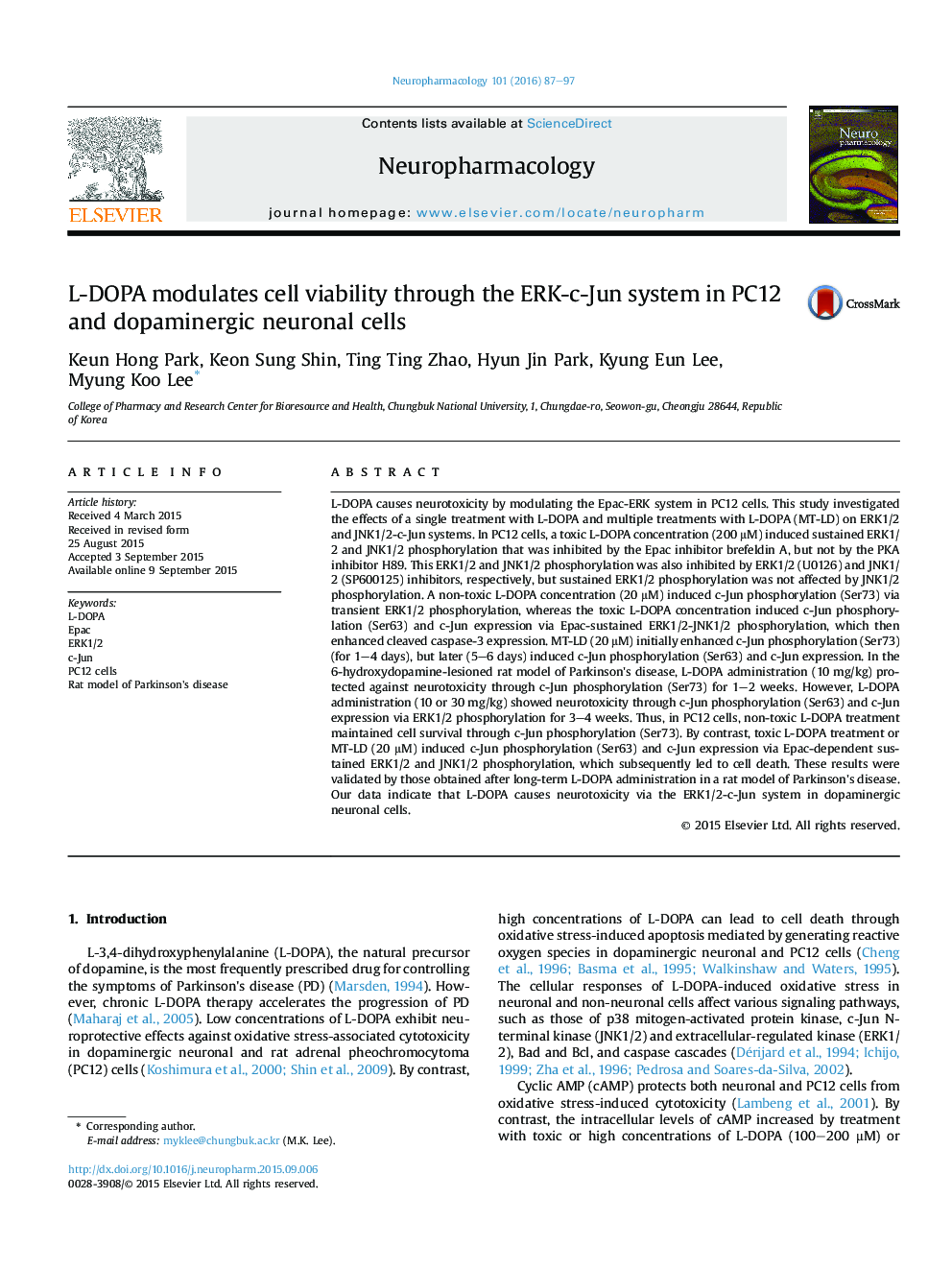| کد مقاله | کد نشریه | سال انتشار | مقاله انگلیسی | نسخه تمام متن |
|---|---|---|---|---|
| 2493102 | 1556614 | 2016 | 11 صفحه PDF | دانلود رایگان |

• In PC12 cells, non-toxic L-DOPA induced cell survival by c-Jun activation (Ser73).
• Toxic L-DOPA treatment induced c-Jun phosphorylation (Ser63) and c-Jun expression.
• Multiple treatments with L-DOPA (20 μM) also induces c-Jun phosphorylation (Ser63).
• These conditions subsequently led to cell death by Epac-sustained ERK-c-Jun system.
• These results were validated by long-term L-DOPA administration in a rat model of PD.
L-DOPA causes neurotoxicity by modulating the Epac-ERK system in PC12 cells. This study investigated the effects of a single treatment with L-DOPA and multiple treatments with L-DOPA (MT-LD) on ERK1/2 and JNK1/2-c-Jun systems. In PC12 cells, a toxic L-DOPA concentration (200 μM) induced sustained ERK1/2 and JNK1/2 phosphorylation that was inhibited by the Epac inhibitor brefeldin A, but not by the PKA inhibitor H89. This ERK1/2 and JNK1/2 phosphorylation was also inhibited by ERK1/2 (U0126) and JNK1/2 (SP600125) inhibitors, respectively, but sustained ERK1/2 phosphorylation was not affected by JNK1/2 phosphorylation. A non-toxic L-DOPA concentration (20 μM) induced c-Jun phosphorylation (Ser73) via transient ERK1/2 phosphorylation, whereas the toxic L-DOPA concentration induced c-Jun phosphorylation (Ser63) and c-Jun expression via Epac-sustained ERK1/2-JNK1/2 phosphorylation, which then enhanced cleaved caspase-3 expression. MT-LD (20 μM) initially enhanced c-Jun phosphorylation (Ser73) (for 1–4 days), but later (5–6 days) induced c-Jun phosphorylation (Ser63) and c-Jun expression. In the 6-hydroxydopamine-lesioned rat model of Parkinson's disease, L-DOPA administration (10 mg/kg) protected against neurotoxicity through c-Jun phosphorylation (Ser73) for 1–2 weeks. However, L-DOPA administration (10 or 30 mg/kg) showed neurotoxicity through c-Jun phosphorylation (Ser63) and c-Jun expression via ERK1/2 phosphorylation for 3–4 weeks. Thus, in PC12 cells, non-toxic L-DOPA treatment maintained cell survival through c-Jun phosphorylation (Ser73). By contrast, toxic L-DOPA treatment or MT-LD (20 μM) induced c-Jun phosphorylation (Ser63) and c-Jun expression via Epac-dependent sustained ERK1/2 and JNK1/2 phosphorylation, which subsequently led to cell death. These results were validated by those obtained after long-term L-DOPA administration in a rat model of Parkinson's disease. Our data indicate that L-DOPA causes neurotoxicity via the ERK1/2-c-Jun system in dopaminergic neuronal cells.
Toxic L-DOPA treatment and multiple L-DOPA treatment (20 μM) in PC12 cells induced c-Jun phosphorylation at Ser63 and c-Jun expression, but not c-Jun phosphorylation at Ser73, via Epac-dependent sustained ERK1/2 and JNK1/2 phosphorylation, which subsequently led to cell death. These results were validated by those obtained following long-term L-DOPA administration in a rat model of Parkinson's disease.Figure optionsDownload as PowerPoint slide
Journal: Neuropharmacology - Volume 101, February 2016, Pages 87–97